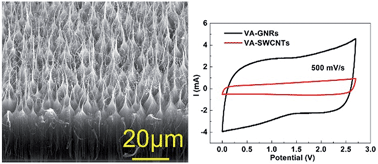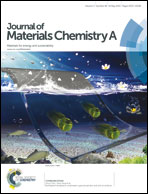Atomic H-induced cutting and unzipping of single-walled carbon nanotube carpets with a teepee structure and their enhanced supercapacitor performance†
Abstract
The atomic H-induced cutting and unzipping of vertically aligned single-walled carbon nanotubes (VA-SWCNTs) with teepee structure and vertical integrity were demonstrated. The resulting structure contains graphene nanoribbons (GNRs) and partially unzipped SWCNTs, which can be completely unzipped by changing the treatment conditions. The advantage of the VA-GNRs over pristine VA-SWCNTs was determined by measuring the specific capacitance based on unit weight. Electrochemical characterization indicated that VA-GNR electrodes achieved a relatively high specific capacitance of 115.7 F g−1 at a power density of 2.7 kW kg−1 and an ultrahigh energy density of 105.6 W h kg−1 has been measured using chronopotentiometry in a 1 M TEABF4 aqueous solution by cyclic voltammetry at a scan rate of 1 A s−1. These values far exceed those of other carbonaceous materials. The excellent rate capability of electrodes from VA-GNRs was attributed to the opening of the side-walls, shortening solid-state lengths for ionic diffusion and electronic transport, and a vertically aligned pathway, all of which facilitate the diffusion of electrolyte ions.


 Please wait while we load your content...
Please wait while we load your content...